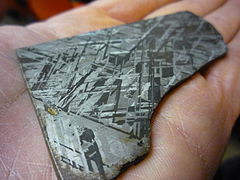陨铁
陨铁(Meteoric iron有时拼写成meteoritic iron)[1]是在陨石内发现,由天然金属的铁和镍为主形成的矿物,主要的形式是锥纹石和镍纹石。陨铁构成了铁陨石的大部分,并且也出现在其他的陨石中。除了少量的地生铁,陨铁是唯一在地球表面可以找到的天然原生金属元素。
| 陨铁(天然铁) | |
|---|---|
 由锥纹石和镍纹石两种铁-镍合金形成的魏德曼花纹 | |
| 基本资料 | |
| 类别 | 天然元素矿物 |
| 化学式 | 不同比率的铁和镍 |
| 晶体空间群 | 不同的结构 |
| 性质 | |
| 光泽 | 金属 |
| 透明性 | 不透明 |
矿物学
编辑大部分的陨铁包含镍纹石和锥纹石。镍纹石是面心立方体,锥纹石是体心立方体的铁-镍合金。
可以从化学上很好的区分陨铁和地生铁,地生铁的镍含量低,而碳含较量高[来源请求]。
追踪陨铁中镓和锗的含量可以区分出不同类型的陨石。石铁陨石的陨铁与铁陨石相同的,被归类为铁陨石的"镓锗集团"[2]。
| 矿物 | 化学分子式 | 镍 (质量-% Ni) | 晶体结构 | 注解和参考 |
|---|---|---|---|---|
| Antitaenite | γLow Spin-(Ni,Fe) | 20-40 | 面心立方体 | IMA已承认为镍纹石的一种品种。 |
| 锥纹石 | α-(Fe,Ni); Fe0+0.9Ni0.1 | 5-10 | 体心立方体 | 结构与铁酸盐相同 |
| 镍纹石 | γ-(Ni,Fe) | 20-65 | 面心立方体 | 结构与奥氏体相同 |
| Tetrataenite | (FeNi) | 48-57 | 正方的 | [3] |
结构
编辑陨铁有几种不同的结构,可以通过陨石的薄片或蚀刻看到。魏德曼花纹是陨铁的锥纹石冷却时从镍纹石的鳞片中转化出来形成[4]。合纹石是这两种矿物在魏德曼花纹的鳞片中共生形成更细微的构造[5]。诺伊曼线是锥纹石晶体经由撞击等影响造成的变形细线[6]。
文化和历史的对待
编辑在冶炼铁出现之前,除了少量大地铁之外,铁陨石是铁金属的唯一来源。陨铁在铁器时代之前已经用来制作文物、工具和武器[7]。
在古埃及格尔津附近墓地发现的金属铁颗粒有7.5%的镍[8][9],在图坦卡蒙的墓穴里发现一把由陨铁制成的匕首[10]。
几个世纪以来,纳玛人都在使用吉丙陨石的碎片。 在西藏,也有使用它们制作各种不同器物的报告(参见护身符,Thokcha),包括铁人、多闻天王的雕像,都是用铁陨石雕刻的[14]。在纪元前1,000年,藏传佛教的雕像,铁人,用来雕刻的铁陨石可能是无纹陨铁;它甚至可能是辛加陨石的碎片[15][16]。
甚至在冶炼发明之后,陨铁还是使用这项技术时不可或缺的稀有金属。在1854年,有一块克兰本陨石被制成一只马蹄铁[17]。
今天,陨铁用在有利可图的珠宝和装饰刀上,但大部分用于研究、教育或收藏的目的。
大气现象
编辑陨铁对地球的大气也有影响。当陨石穿过大气层下降时,外面的部分会烧蚀。流星的烧蚀是上层大气层中许多元素的来源,当陨铁烧蚀时会形成自由的铁原子,可以与臭氧作用形成氧化亚铁(FeO)。氧化铁是高层大气中橙色频谱带的来源[18]。
相关条目
编辑参考资料
编辑- ^ Rehren T, et al., "5,000 years old Egyptian iron beads made from hammered meteoritic iron", Journal of Archaeological Science 2013 text (页面存档备份,存于互联网档案馆)
- ^ Lovering, John F.; Nichiporuk, Walter; Chodos, Arthur; Brown, Harrison. The distribution of gallium, germanium, cobalt, chromium, and copper in iron and stony-iron meteorites in relation to nickel content and structure. Geochimica et Cosmochimica Acta. 31 December 1956, 11 (4): 263–278. doi:10.1016/0016-7037(57)90099-6.
- ^ Clarke, Roy S.; Edward R. D. Scott. Tetrataenite - ordered FeNi, a new mineral in meteorites (PDF). American Mineralogist. 1980, 65: 624–630 [13 December 2012]. (原始内容存档 (PDF)于2015-02-26).
- ^ Yang, J.; J. I. Goldstein. The formation of the Widmanstätten structure in meteorites. Meteoritics & Planetary Science. 2005, 40 (2). doi:10.1111/j.1945-5100.2005.tb00378.x.
- ^ Goldstein, J. I.; J. R. Michael. The formation of plessite in meteoritic metal. Meteorics & Planetary Science. 2006, 41 (4): 553–570. doi:10.1111/j.1945-5100.2006.tb00482.x.
- ^ Rosenhain, Walter; Jean McMinn. The Plastic Deformation of Iron and the Formation of Neumann Lines. Proceedings of the Royal Society. 1925, 108: 231–239. doi:10.1098/rspa.1925.0071.
- ^ Waldbaum, J. C. and James D. Muhly; The first archaeological appearance of iron and the transition to the iron age chapter in The coming of the age of iron, Theodore A. Wertme. ed., Yale University Press, 1980, ISBN 978-0300024258
- ^ Pre-Dynastic Iron Beads from Gerzeh, Egypt. ucl.ac.uk. [28 December 2012]. (原始内容存档于2015-04-07).
- ^ Rehren, Thilo; Belgya, Tamás; Jambon, Albert; Káli, György; et al. 5,000 years old Egyptian iron beads made from hammered meteoritic iron. Journal of Archaeological Science. 31 July 2013. doi:10.1016/j.jas.2013.06.002.
- ^ Bjorkman, Judith Kingston. Meteors and Meteorites in the ancient Near East. Meteoritics. 1973: 91–132. doi:10.1111/j.1945-5100.1973.tb00146.x.
- ^ Iron and steel in ancient times by Vagn Fabritius Buchwald - Det Kongelige Danske Videnskabernes Selskab 2005
- ^ T. A. Rickard. The Use of Meteoric Iron. Journal of the Royal Anthropological Institute (Royal Anthropological Institute of Great Britain and Ireland). 1941, 71 (1/2): 55–66. JSTOR 2844401. doi:10.2307/2844401.
- ^ Buchwald, V. F. On the Use of Iron by the Eskimos in Greenland. Materials Characterization. 1992, 29 (2): 139–176. JSTOR 2844401. doi:10.1016/1044-5803(92)90112-U.
- ^ Der Lama mit der Hose: „Buddha from space“ ist offenbar eine Fälschung (Telepolis 13.10.2012). [2015-03-14]. (原始内容存档于2012-12-19).
- ^ Ancient Buddhist Statue Made of Meteorite, New Study Reveals. Science Daily. [26 December 2012]. (原始内容存档于2015-02-27).
- ^ Buchner, Elmar; Schmieder, Martin; Kurat, Gero; Brandstätter, Franz; et al. Buddha from space-An ancient object of art made of a Chinga iron meteorite fragment*. Meteoritics & Planetary Science. 1 September 2012, 47 (9): 1491–1501. doi:10.1111/j.1945-5100.2012.01409.x.
- ^ The Cranbourne Meteorites (PDF). City of Casey. [29 December 2012]. (原始内容 (PDF)存档于2013-05-10).
- ^ Evans, W. F. J.; Gattinger, R. L.; Slanger, T. G.; Saran, D. V.; et al. Discovery of the FeO orange bands in the terrestrial night airglow spectrum obtained with OSIRIS on the Odin spacecraft. Geophysical Research Letters. 20 November 2010, 37 (22). doi:10.1029/2010GL045310.